The OriginTrail blockchain was created to enable trusted data sharing along supply chains. It allows companies, organizations, and even other blockchains to safely and securely share information in its fully decentralized knowledge graph network.
The data in the network is secured through monitoring activities of oracles and artificial intelligence agents. The OriginTrail protocol allows for expiration of data, and sensitive data can be protected through the use of zero-knowledge methods.
At its most basic level OriginTrail is a collection of decentralized network nodes holding and sharing data. The network’s TRAC token is what brings everything together on the network, and it can be used to keep data immutable and nodes honest (as a staking token), or as a payment token that compensates nodes for their resources and time. In total there are at least 6 different ways in which TRAC can be used.
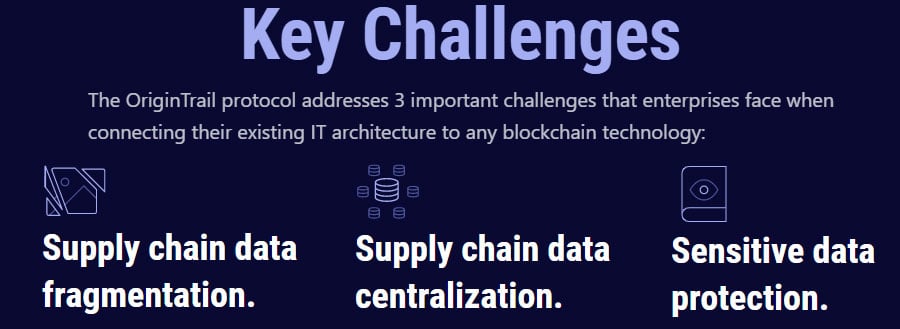
Some of the key challenges that supply chains face. Image via Origin Trail Website
Adoption of the protocol is being bootstrapped through the adherence to globally recognized standards for data sharing. The OriginTrail team has been actively working with GS1 (the bar code registration organization) to develop the next generation EPCIS/CBV 2.0 supply chain standard.
As an aid to adoption the team at OriginTrail has also solved the problem of companies buying and holding cryptocurrency for use in its network through its exchange integrations and enterprise software.
The OriginTrail Protocol
OriginTrail enables data sharing for supply chains in a neutral, decentralized, open-source protocol. The network is comprised of nodes and an off-chain technology stack that was designed to allow the blockchain to interface with legacy software systems and other blockchains. With OriginTrail companies are able to enjoy trusted data exchange, and improve the interoperability of their legacy systems.

Decentralized data sharing for supply chains. Image via OriginTrailExplained.info
The protocol is designed to address three challenges that all enterprises face when attempting to connect their legacy systems to blockchains:
Supply Chain Data Fragmentation – All supply chains have an issue with low data interoperability and with the existence of data silos. These create significant roadblocks when organizations seek to build collaborative applications, and when they attempt to establish supply chain transparency.
Supply Chain Data Centralization – Data silos lead to centralization as current methods for removing such silos revolve around aggregating the data in a centralized manner. This has led to concerns regarding the integrity of the data and omitting accountability. Data tampering is also a huge concern whenever data is under centralized control. Existing decentralized networks cannot support supply chain applications in the transition to decentralization due to shortfalls with (1) data scalability, (2) lack of adequate database functionalities and/or (3) not being entirely neutral (permissionless).
Sensitive Data Protection – Companies typically worry about any data sharing compromising their competitive position, meaning they remain very reluctant to share data unless it is required for regulatory reasons or because they are forced to do so. With centralized data exchange there are no protections for sensitive data, and this stops many companies from creating new business models.
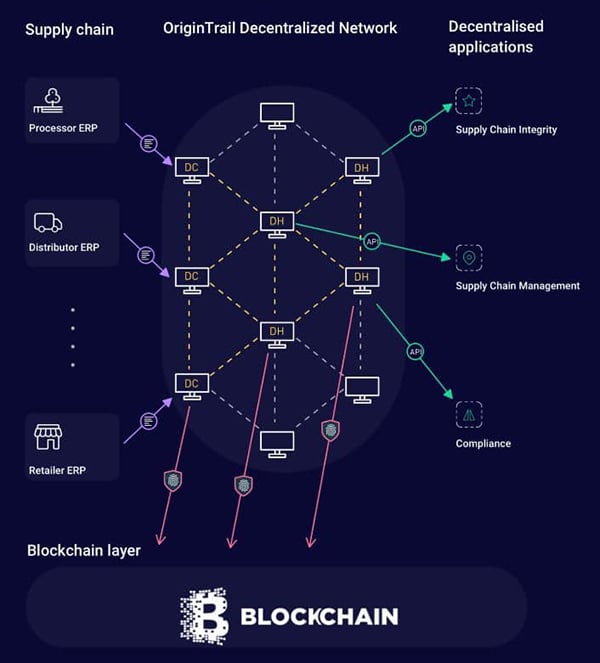
Solving three key challenges faced by supply chain technology. Image via OriginTrail.io
OriginTrail Network Features
The OriginTrail Decentralized Network (ODN) went live in its mainnet in December 2018 and has been processing enterprise data jobs since. It addresses the three challenges above through its four core technological features:
Interoperability and Data Integrity
In order to promote interoperability the OriginTrail network was built in accordance with the GS1 and W3C standards. Using these global standards allows data to be aligned efficiently, even when taken from multiple sources that include older legacy systems and newer blockchain systems.
The data can be anything from descriptive data and tracking data to Internet-of-Things (IoT) data. After aligning the data there are consensus checks performed to verify datasets. Additionally, auditing from third-party organizations can be authorized automatically. Because many supply chain cases deal with sensitive data the ODN was designed using zero-knowledge proofs to prove data validity.
Data Immutability
Data is made immutable by creating a tamper-proof cryptographic hash of the data. This is similar in nature to a fingerprint, and after being created the hash is placed on the blockchain. Later it can be used to verify that the data has not been modified or tampered with in any way.
Stability & Cost Efficiency
Most of the heavy lifting that involves data integrity and interoperability occurs offchain. That allows the ODN to operate more efficiently and cheaply. And because it is an open source system it is easy to deploy and integrate with existing legacy systems.
Network Incentivization via Token Staking
The TRAC token serves several functions, one of which is to compensated data creators, holders, and consumers. The staking system used by OriginTrail is one that keeps all the parties involved in the network honest, which incentivizes nodes to deliver data on demand and to perform the necessary consensus checks.
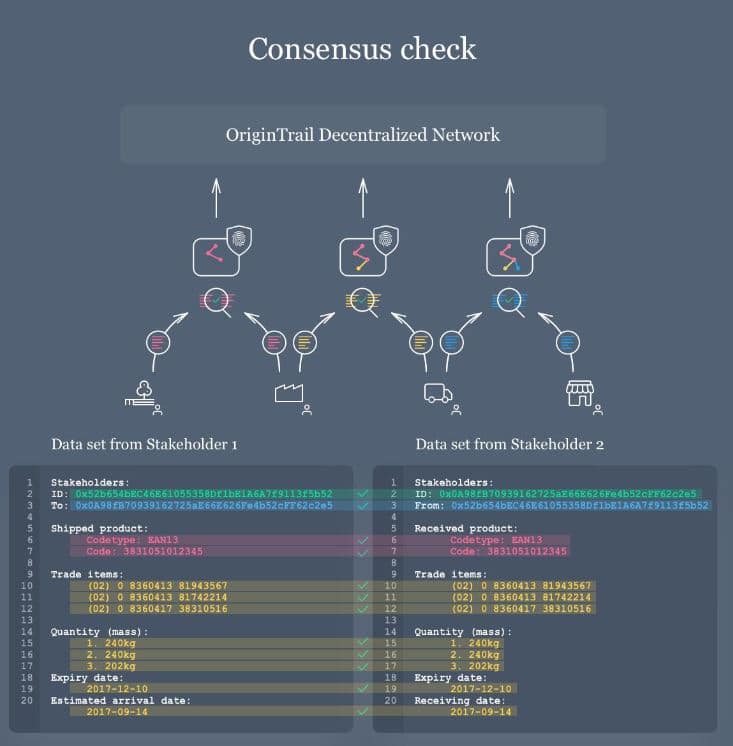
Attempting to keep trust between all parties on the network. Image via OriginTrail.io
These four core technological features work together to overcome one of the serious limitations in a centralized blockchain solution – keeping trust between all the parties in the network. At the core of the system is a decentralized network of data providers, data creators, data holders, and data viewers.
Network Entities
In order to better understand the OriginTrail P2P network structure and the incentive mechanisms within the protocol, we have to understand all the different roles within the context of the system. The main premise is that the nodes have different interests, given their roles. Below is a list of different entities and their roles in the system.
- Data Provider – The Data Provider (DP) is an entity that publishes supply chain data to the network. The interest of the Data Provider is to be able to safely store data on the network, as well as to be able to connect it and cross-check with the data of other DPs within the network.
- Data Creator Node – The Data Creator node (DC) is an entity representing a node that will be responsible for importing the data provided by the DP, making sure that all the criteria of DP are met. The primary responsibility of the DC node is to negotiate, establish and maintain the service requested by the DP in relationship with its associated Data Holder (DH) nodes.
- Data Holder Node – The Data Holder (DH) is a node that has committed itself to storing the data provided by a DC node for a requested period of time and making it available for the interested parties. There is a certain risk that these Data Holders may offer false data or tamper with the data, or even pretend to have data that they don’t have. To mitigate this risk, a node will be required to deposit a stake for executing an agreement.
- Data Viewer – The Data Viewer (DV) is an entity that requests data from any network node able to provide that data. The interest of the Data Viewer is to get the data for as affordable as possible, but also to be sure that the provided data is genuine. Therefore, the Data Viewer also has an opportunity to initiate the litigation procedure in case the data received is not valid, which could lead to slashing if it is proven that false data was provided.
OriginTrail Data Flow
The Data Creator node is where data enters the ODN. The source of this data could be from any one of a number of business functions. When the data enters the system a cryptographic hash is imprinted and stored to the blockchain to ensure data immutability. The data is subsequently passed to 3 or more Data Holder nodes to store the data.
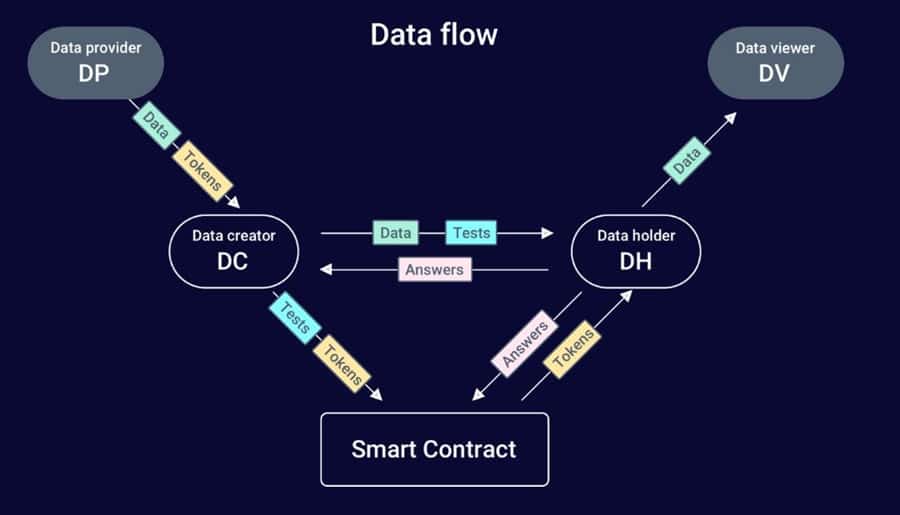
The flow of data is clear and easy to follow. Image via OriginTrail.io
The stored data can be handled in whatever way the data creator desires. Data can be set as public or private, it can be set to expire after a set amount of time, or it can be limited to sharing with only a certain party or group of parties. Sensitive data is protected using zero-knowledge methods in a privacy-by-design approach.
The data holding nodes create a vast decentralized knowledge graph and they are capable of connecting data sets across supply chain partners quickly and efficiently. This is one of the main selling points for the protocol, since finding inter-related data between partners has not been possible until now.
The data holding nodes were designed as extremely decentralized. Anyone who holds 3,000 TRAC tokens or greater can run a data holding node. Jobs are randomly assigned too nodes whenever the job meets the node criteria. The nodes are exactly the same, and the only benefit to staking more than 3,000 TRAC is that nodes are then able to accept additional jobs. As of February 2021 there are over 700 data holding nodes in the OriginTrail network.
All the network entities are connected in the system through the TRAC token. This is the glue holding everything together, and TRAC can be used both to stake and keep data holders honest and data immutable, as well as a payment to compensate the data holders for the use of their resources and time.
Blockchain Interactions
One of the other useful features of ODN is that because it is a middle-layer protocol it can interact with various other blockchains. Below are some of the connected blockchains, and planned connections in the coming months:
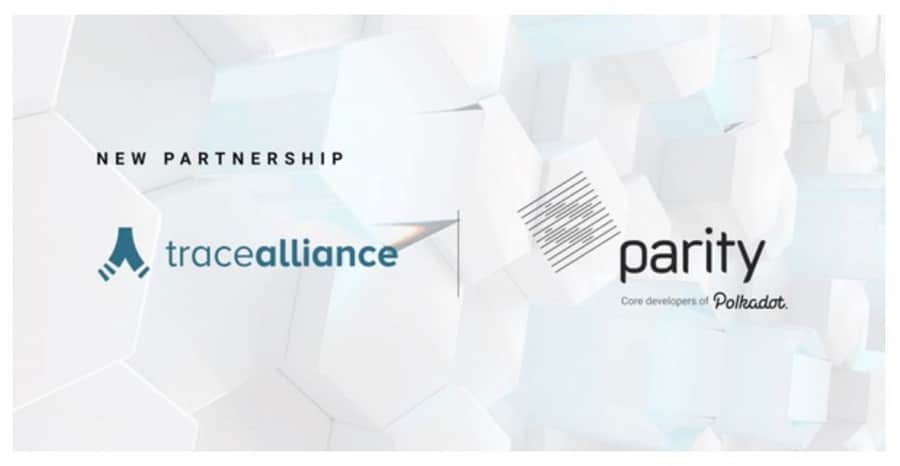
Soon OriginTrail will have the ability to connect with nearly any blockchain. Image via Medium.com
Ethereum – OriginTrail is currently using the Ethereum blockchain to store all the cryptographic hashes created when data enters the ODN. However the massive increase in gas prices for the Ethereum network has made data job prices prohibitively expensive. The project will be able to get past this once they launch their own StarFleet chain sometime in the second quarter of 2021.
HyperLedger Fabric – This was the second blockchain bridged, and smart contract integrations were first connected in late 2018.
xDai – The xDai integration is expected to take place on March 23, 2021. The OriginTrail developers chose xDai for its mature ecosystem, and its secure, production-grade bridges to Ethereum. After the xDai integration goes live the developers say there will be a standardized process of integration and any blockchain ecosystem wanting to benefit from the OriginTrail Decentralized Knowledge Graph will be capable of integrating.
Polkadot – The OriginTrail Trace Alliance formed a partnership with Polkadot’s creators Parity in September 2020, but the integration of Polkadot has been delayed and whether parachains or parathreads will be used has yet to be decided.
StarFleet Chain – The StarFleet chain is an in-house blockchain being developed to minimize the transaction costs for the ODN. It will also add additional utility to the TRAC token by creating an added “tokenized” form called sTRAC. There will be a bridge created to allow the ERC-20 TRAC token onto the StarFleet chain, and tokens transferred in this way will be locked in smart contracts, with corresponding sTRAC tokens created. Additional utility will be unlocked through the creation of Knowledge Tools, where TRAC is used to transfer knowledge from producers to consumers.
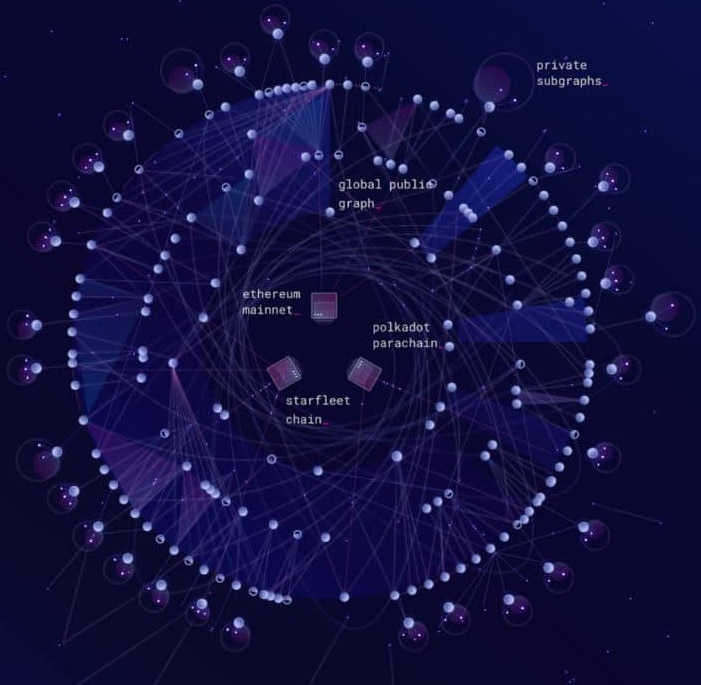
The launch of StarFleet will make transactions far cheaper. Image via OriginTrail.io
TRAC Utility & Economics
The Trace token (TRAC) is an ERC-20 utility token used to power the entire OriginTrail ecosystem. It was pre-mined with a total supply of 500 million tokens, and is non-inflationary. It is divisible down to 18 decimal places, so there should never be an issue with supply. Ultimately it is believed that the price of a data job on the ODN will remain stable as the value of TRAC increases in-line with adoption.
TRAC Utility
As mentioned at the start of this review, there are six ways in which the TRAC token provides utility within the ODN. It should also be noted that the network is incapable of functioning without the TRAC token. Here are the six mechanisms of utility for TRAC:
- Participating in the OriginTrail Ecosystem. Data creators and holders must stake TRAC to run their nodes. The amount of TRAC staked determines the number of data jobs that can be held or published.
- Publishing data to the ODN. When data creators publish data jobs on the ODN they use TRAC to compensate the data holders for their time and resources. The value of TRAC required for each job is dependent on market forces, but it is also influenced by data size and job length.
- Collateralization by Data Holders. As a way to prevent data tampering, and as a promise to hold data for a set period of time, TRAC from a data holder’s stake is also locked via smart contract for the length of the data job. This staked TRAC is slashed if the node fails to provide the data it is holding on-demand. Once the job is completed the data holder receives their own stake back, plus the stake of the data creator.
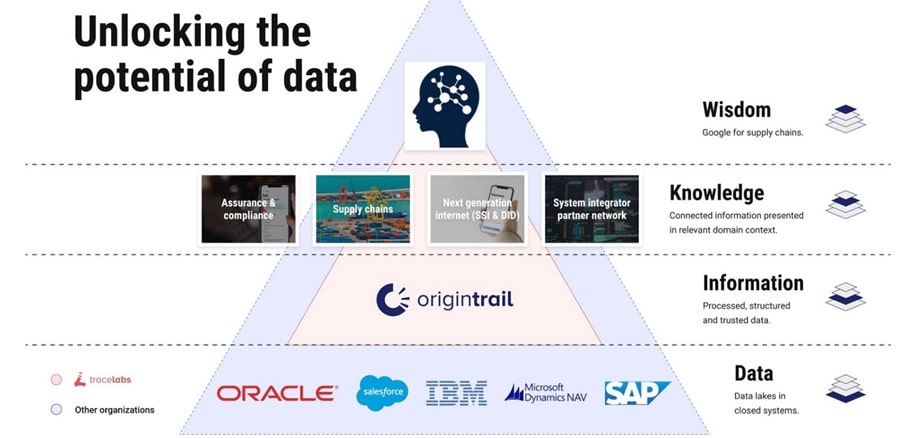
Data has so much potential for supply chains. Image via TraceLabs.io
Additional TRAC Utility will be Catalyzed via TRAC Usage on the StarFleet Chain
- sTRAC Usage as StarFleet Chain Native Token. The StarFleet Chain is a new blockchain developed by the OriginTrail team as a way to make transactions less expensive. It is expected to launch in the second quarter of 2021 and will use a wrapped form of TRAC called sTRAC. A bridge will be developed for ease of token movement between chains.
- Staking sTRAC. Just as TRAC can be staked, it will also be possible to stake sTRAC on the StarFleet chain. This will allow stakers to collect some of the profits from data data jobs. It also helps constrain the supply of TRAC and sTRAC since staked coins might remain lacked into the network for months or even years.
- Knowledge Incentivization. The final current use-case for TRAC will come from the ability of data creators to sell their data on the open marketplace. There are already Data Markets being built for both pharmaceuticals and satellite imagery. This has the potential to unlock valuable proprietary siloed data previously thought unsellable.
StarFleet Chain will super-charge these data marketplaces with the addition of knowledge tokens, knowledge wallets, the knowledge marketplace, and knowledge tenders. They will allow individuals to buy and sell data in a trusted, private way. The developers say this will increase TRAC’s utility by orders of magnitude.
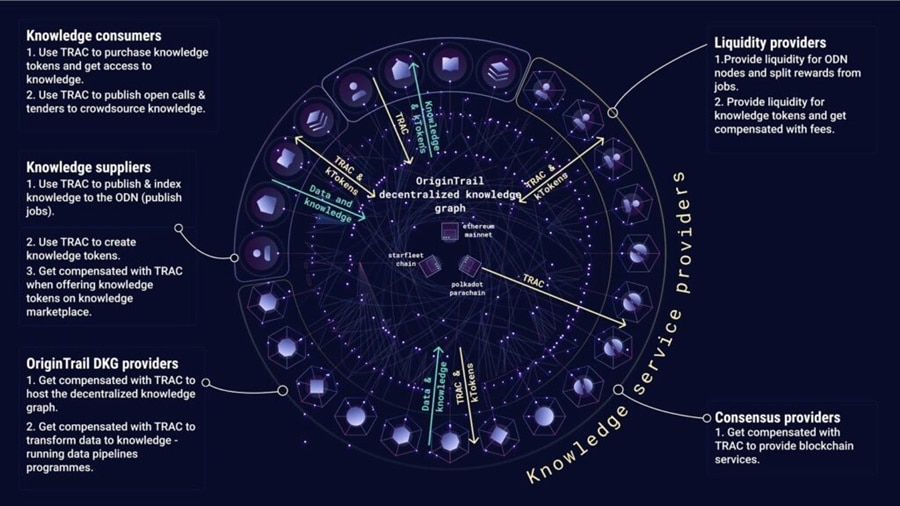
StarFleet will help bring about the Knowledge Economy. Image via OriginTrail.io
TRAC Token Economics
Given that TRAC is solely a utility token its price should be highly correlated with the usage of the ODN. It is thought that TRAC token scarcity will be subject to a triple effect as described in OriginTrail’s 2019 Vision Paper:
When the TRAC token economics and all of the above utilities are put into practice, they create a triple effect. When data gets published on ODN, the publisher creates a certain demand for TRAC that is used to compensate the nodes in the network for holding the published data. At the same time, the same demand gets created for TRAC that is put as collateral for that particular job. While that collateral gets locked, it effectively also lowers the entire available supply of TRAC, thus creating the third effect.
In addition to speculation and investment, there are two forces that can be expected to exert upward pressure on the price of TRAC:
- Token Lockup by Staking, Nodes and Data Jobs. Locking tokens in the network will theoretically take massive amounts of TRAC out of circulation, potentially for very long periods of time. Reduced circulating supply should have a positive impact on price. For example, the average length of a data job is 6 months. That means the tokens staked for each job will remain out of circulation for an average of 6 months. In September 2020 the OriginTrail team suggested there could be anywhere from 10,000 to 100,000 jobs on the network per day by 2023. Also don’t forget the StarFleet Chain, which might be expected to lock up 10-20% of the circulating supply when it launches.
- Direct Exchange Integration. The Network Operating System (nOS) is the link between the ODN and existing enterprise software. Companies using the nOS automatically purchase TRAC on exchanges. This not only increases demand for TRAC, it also solves the problem that companies have had in relation to purchasing and holding cryptocurrency.
The ICO for TRAC was held back in January 2018, with half the total supply (250,000,000 TRAC) being offered at $0.10 each. The ICO saw all of the tokens being sold. Trading in the token began roughly a week after the ICO, and price immediately more than doubled. By April 2018 price had dipped back near ICO levels, but then a second rally saw the price of TRAC exceeding $0.30 by May 15, 2018.
Price fell again, eventually reaching an all-time low of $0.003785 on March 13, 2020. Early investors may have been quite disappointed at this point, but hopefully they held on, because over the coming year the TRAC token surged higher, and almost exactly one year later on March 17, 2021 the TRAC token hit its all-time high of $0.8903.
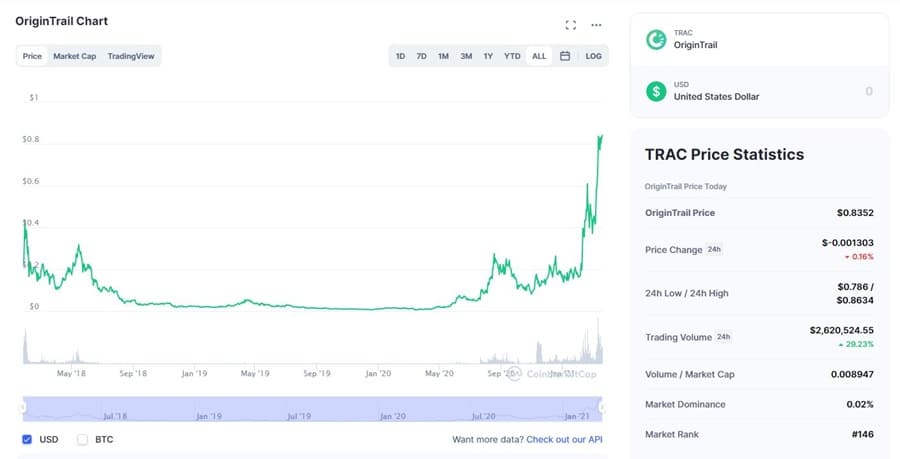
The price history of the TRAC token. Image via Coinmarketcap.com
The OriginTrail Team
The OriginTrail team doesn’t have any of the big names from other blockchain projects, nor does it have any industry leaders as part of the team. That seems unusual when you consider that acquiring big-name partners is one of the keys to success for the project. Yet it hasn’t held them back in any way, as their track record clearly shows.
One thing that is very interesting to learn is that the project has been around since the release of an Alpha version of their platform in 2013. And OriginTrail was formed in 2011. That makes them one of the older blockchain projects around.
When you consider the small size of the team and the lack of big names, it is quite exceptional to see the list of partners attracted to the project. In the coming months and years they will need to build on this, reaching out to other global partners in order to expand their own branding.

The three founders of OriginTrail. Image via OriginTrail.io
The CEO and a founding member of OriginTrail is Tomaz Levak. He is also a member of the Ethereum Enterprise Alliance Supply Chain working group and has experience managing tech projects in Europe and the Middle East.
OriginTrail’s second founding member and COO is Ziga Drev. He has previously managed complex supply chain setups in Europe and Asia, giving him deep experience in space that has helped in building OriginTrail.
The third founding member of OriginTrail and its CTO is Branimir Rakić. He has been working to introduce blockchain to supply chains since 2016. There is a lot of academic backgrounds and coding experience, but not much institutional depth.
TraceLabs
Trace Labs is the for-profit company that is owned by the same three founders of OriginTrail. It serves as the core development team for the protocol.
They are helping to grow the platform by creating custom solutions for clients and have consistently stated that they are well funded and incredibly busy. One of the stated goals of Trace labs is to connect at least 100,000 organizations to the ODN by 2023. It’s a very ambitious goal to be sure.
Network Operating System (nOS)
One of the biggest catalysts for ODN adoption is the Network Operating System (nOS) built by Trace Labs. It is custom built software that directly connects the ODN to legacy enterprise software and to other blockchains.
It makes ERP integrations easy and allows for consensus checks for data discrepancies among partners, supply chain/track-and-trace applications, and data/sourcing provenance. The developers at Trace Labs have suggested that nOS decreases both implemtation times and deployment costs by as much as 10-fold.
nOS is already integrated into several legacy enterprise suites, including Oracle Cloud, Salesforce, SAP, and Microsoft Navision. This enables 10,000+ businesses ready access to nOS functionality with a single click.

OriginTrail has been tested by many global brands. Image via TraceLabs.io
Perhaps the best feature of nOS in terms of future adoption is that it enables automated purchases of TRAC with the company’s fiat funds. This is key for many organizations since the TRAC purchased is only used in the background. Because the TRAC never hits the accounting books of the company it solves the problem of companies needing to buy and hold cryptocurrency.
Open Standards
Integrating with the existing global standards for supply chains has been one of the solid moves that is increasing adoption of OriginTrail too. The global supply chain industry runs on the standards developed by GS1.
These standards have all been developed over the past 4+ decades and they allow for the interoperability of various systems and supply chain architectures. It’s clear that any blockchain based solution for the global supply chain industry should incorporate these standards, and OriginTrail was developed from the ground up with these standards incorporated.
The OriginTrail protocol also supports the Web of Things (W3C) recommended standard. This will ensure wide compatibility with IoT devices and has already been utilized for a number of European Union-wide use cases and pilots.
OriginTrail’s standards-based approach also caught the attention of the World Economic Forum (WEF), who detailed OriginTrail as one of the top blockchain-based supply chain solutions in their 2020 Blockchain Deployment Toolkit report. They also published an article on OriginTrail’s Essential COVID-19 Supplies Repository as an effective use of blockchain technology.
Conclusion
OriginTrail is tackling real-world problems in the supply chain system and easing the pain point experienced in the transition to blockchain based solutions. With the global supply chain industry seen as a perfect use case for blockchain, a project like OriginTrail that can create a platform that allows for trust, ease of integration, and improved tracking and data storage could take over the industry in the coming years.
Moreover, OriginTrail is not one of the over-hyped crypto projects that are so common. It’s a project that’s been years in the making, even before adopting a blockchain approach. The team is not well-known and famous within the blockchain ecosystem, but they have done an excellent job in growing OriginTrail and in acquiring partners. If they can continue this growth trajectory they should become a strong force within the supply chain industry.
Featured Image via Shutterstock
Disclaimer: These are the writer’s opinions and should not be considered investment advice. Readers should do their own research.
- &
- 000
- 100
- 2016
- 2019
- 2020
- access
- Accounting
- activities
- Additional
- Adoption
- advice
- agents
- Agreement
- All
- Alliance
- among
- applications
- April
- around
- article
- artificial intelligence
- asia
- Automated
- BEST
- Biggest
- blockchain
- blockchain projects
- blockchain technology
- Books
- branding
- brands
- BRIDGE
- build
- Building
- business
- businesses
- buy
- Buying
- cases
- caught
- ceo
- Checks
- Cloud
- code
- Coding
- Coins
- coming
- Common
- Companies
- company
- Connections
- Consensus
- Consumers
- continue
- contract
- contracts
- coo
- Costs
- COVID-19
- Creating
- creator
- crypto
- cryptocurrency
- CTO
- Current
- data
- data sharing
- data storage
- Database
- day
- dc
- deal
- Decentralization
- decentralized
- decentralized network
- Demand
- develop
- developers
- Development
- Devices
- Early
- easing
- Economic
- Economics
- economy
- ecosystem
- Effective
- Enterprise
- enterprise software
- Enters
- ERC-20
- ethereum
- ethereum network
- Europe
- European
- exchange
- Exchanges
- Expand
- Face
- Feature
- Features
- Fiat
- First
- flow
- follow
- form
- founders
- funded
- funds
- future
- GAS
- Giving
- Global
- Group
- Grow
- Growing
- Growth
- hash
- here
- High
- history
- hold
- HTTPS
- huge
- ICO
- image
- Impact
- importing
- Including
- Increase
- industry
- information
- Institutional
- integration
- integrations
- Intelligence
- interest
- Interoperability
- investment
- Investors
- involved
- iot
- iot devices
- IT
- Job
- Jobs
- keeping
- Key
- keys
- knowledge
- Labs
- launch
- launches
- lead
- LEARN
- Led
- Level
- Limited
- LINK
- List
- Litigation
- Long
- Making
- March
- Market
- marketplace
- Markets
- Microsoft
- Middle East
- million
- monitoring
- months
- names
- Near
- network
- networks
- nodes
- offer
- open
- open source
- operating
- operating system
- Opinions
- Opportunity
- oracle
- order
- orders
- Other
- p2p
- Pain
- Paper
- Partnership
- payment
- pharmaceuticals
- platform
- power
- pressure
- price
- private
- Producers
- project
- projects
- promote
- public
- publish
- purchase
- purchases
- rally
- readers
- reasons
- Registration
- report
- research
- Resources
- review
- Risk
- Run
- sap
- Scalability
- sell
- set
- Share
- SIX
- Size
- small
- smart
- smart contract
- Smart Contracts
- So
- Software
- sold
- Solutions
- Space
- stake
- Staking
- standards
- start
- storage
- store
- Store the data
- success
- supply
- supply chain
- Supply chains
- support
- Supports
- system
- Systems
- tech
- Technology
- The Source
- time
- token
- Tokens
- top
- track
- Tracking
- Trading
- transaction
- Transactions
- Transparency
- Trust
- utility
- Utility Token
- value
- vision
- Wallets
- web
- week
- WEF
- WHO
- within
- Work
- world
- World Economic Forum
- year
- years
- zero-knowledge proofs













